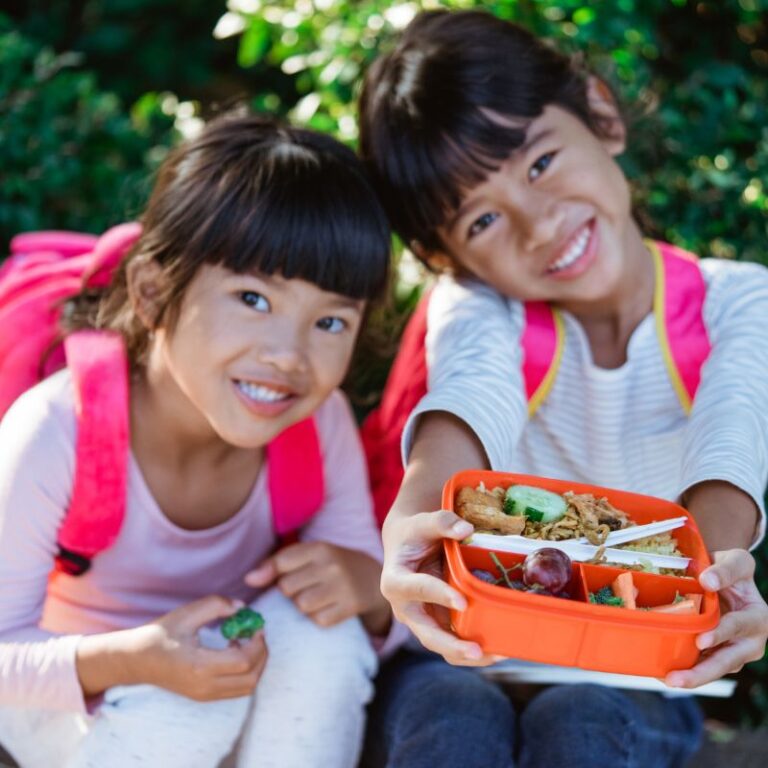If you’ve got a little one starting school this year, you’re likely in the process of gearing them up for a LOT of transitions. New schedules, new routines, new teachers, new friends and more. One of those transitions will no doubt include your child eating a packed lunch. Whether you have an easy-eater or more selective eater, this is a big transition for both parent and child. Since life is easier with a checklist, here are 10 Steps to School Lunch Packing Success!
STEP 1 – Consider what type of food you will pack most often.
This is so important! You want to figure out what types of food, snacks, and meals you are going to pack most often and get lunchbox gear that fits that food! For example, does your kiddo LOVE having a sandwich or sub bun every day? If so, a bento box with tiny compartments is not going to work. Or do they love leftovers? If so, investing in a really good quality thermal food jar is a must.
It’s vitally important to think of this first BEFORE you buy your lunch gear! You don’t want to invest a ton of money into stuff that your kiddo will essentially never use. On the contrary, you may want to invest in good quality gear that your child will use every day.
STEP 2 – Buy the lunchbox gear that suits the food.
Once you know what food you’ll send most often, you need to research (and then purchase) the gear you will need. There are so many cool lunch containers out there but the only ones that you should buy are the ones that will work for the food your kid will routinely eat.
Here are 9 items that you will want to consider buying for your kiddos’ school lunches:
- Bento box
- Containers
- Reusable snack bags
- Cold packs
- Utensils
- Thermal food jar
- Water bottle
- Lunch bag
- Miscellaneous items (e.g., labels, hand sanitizer etc.)
Since there are a bajillion different brands and products for each of these categories, you may want to get a little expert help before you waste thousands of hours researching everything. School Lunches 4 Kids covers this and more! Our Lunchbox Gear Guide comes with our top recommendations in each category. We include a specs sheet that compares features and prices.
STEP 3 – Practice opening (and closing) containers.
This often-overlooked step is vitally important to your child eating at school. If your kid can’t open their containers independently, they may spend most of their lunch period with their hands in the air, waiting for help, and not around their sandwich eating. Let’s not forget the importance of them also knowing how to close their containers! No one wants a stinky lunch bag with food mushy into the zippers.
Some families take their kiddo shopping with them and make sure they can open containers in the store before they buy them. Other families buy online, and then see if their kiddo can open it. If not, they return the containers. Whichever you choose, the important part is that they can open them and close them on their own.
So, practice, practice and practice some more. August is a great time to plan a few picnics with your child’s new lunch gear. Don’t forget to let them practice opening other things like food wrappers too. (Better yet, take the wrappers off the food before you send it to school).
STEP 4 – Find out when the school’s food breaks are and how long they are.
Don’t assume that lunch break will happen at noon. Every school has different schedules and lunch breaks may be offered as early as 10 a.m. and as late as 2 p.m. Some schools offer two short recess breaks and one longer lunch break. Other schools have only 2 short food breaks. Head to your child’s school website and find out when the food breaks are scheduled.
Additionally, it’s extremely helpful to check how long they’ll have to eat their lunch at each break. At many schools, kids are only given 20 minutes or less to eat!
*Note that oftentimes kindergarten classrooms will have a slightly different schedule then what is posted online and/or the kids may be given a longer time to eat their food at each break. It’s best to ask your child’s specific educator about their classroom rules.
STEP 5 – Give your kiddo practice eating (independently) at these times.
Once you have this information, for the last week or two before school starts, you can offer your child lunch and snacks at the school break times. Don’t forget to set a timer for how long they’ll have to eat. By no means do you need to cut them off from eating if they’re not done when the timer goes off. It’s just good to give them an awareness of how much time they’ll have at school. This sort of practice will get their tummies acclimatized to eating at the school break times.
STEP 6 – Decide WHO will pack and WHEN you will pack.
It’s important to have a game plan for who will be the point person for packing lunches, or the ‘overseer’ if your child is packing their own lunch. If you want to share the duty with your parenting partner, speak up! I highly encourage families talk about this in advance so it’s not a point of frustration every time lunches have to be made.
Equally as important, you need to sort out when the packing of lunches will occur. This may likely be dictated by your own job and schedule. You may also need to think about whether your child will eat food that has sat in their lunchbox in the fridge all night. Or perhaps you’ll decide to pack part of their lunch the night before and part in the morning. This can change but it’s good to have a plan to start and adjust from there.
STEP 7 – What sort of food prep do you need/want to do?
Some families thrive on having lots of food prepped on the weekend to make packing lunches easier during the week (e.g., pre-washing and chopping fruits and veggies, baking muffins, maybe hard-boiling some eggs, prepping an entree etc.) Other families find this overwhelming and too hard to do with their schedules. That’s okay! The best approach is the plan that works for your family, your routines, and your schedule.
STEP 8 – Anticipate “lunch-making decision-fatigue” and make a plan to conquer it!
Whether it happens the first week or the last week, I’m going to guess that at some point, you are going to run into “lunch-making decision-fatigue”. This is the unofficial term I give to parents always wondering “what the heck do I pack for lunch today?” Having a selective eater can bring on “lunch-making decision-fatigue” much quicker than you think.
You can pre-emptively conquer this by creating a master list of ideas that you can refer to when you need inspiration. You can research or brainstorm your own ideas and ask friends for ideas too.
Don’t forget that you can also spring-start this process by using our 10-page School Lunch Ideas Master List in our School Lunches 4 Kids Master Class.
STEP 9 – Be open to experimenting and troubleshooting.
Despite your best efforts to practice and plan, you may run into some hurdles as you send the next ~200 lunches to school: this is 100% normal!
Be open to experimenting and trying new ways of packing foods and learning what works and doesn’t work. Don’t take it personally if something comes home. Use this as an opportunity to learn a bit more about your child and their experience of eating at school. Don’t forget to ask about their classroom food rules. Sometimes certain rules, like “eat your healthy food first” make it more difficult for them to eat.
STEP 10 – Remember the KISS principle!
Keep It Simple Silly! Packing lunches is not a sport or competition. It also says nothing about your ability to parent. At the end of the day, your child needs safe food and adequate food to fuel their learning. That’s it. Period. So, focus on these two things first and foremost.
If you want to dive deeper into each of these topics, be sure to check out School Lunches 4 Kids Master Class. Our online course opens August 1st each year and helps parents tackle lunchbox gear, lunchbox food and how to navigate school food rules. Find out more here.








